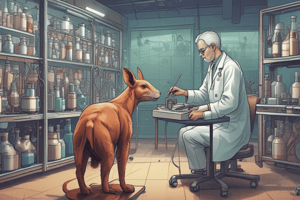Podcast
Questions and Answers
Which of the following is an acceptable method for anesthesia in small laboratory rodents?
Which of the following is an acceptable method for anesthesia in small laboratory rodents?
Under what conditions can CO2 be used as an inhaled anesthetic in small rodents?
Under what conditions can CO2 be used as an inhaled anesthetic in small rodents?
What is the acceptable method for physical anesthesia in mice and rats?
What is the acceptable method for physical anesthesia in mice and rats?
Which of the following methods is not acceptable as an anesthetic for small laboratory rodents?
Which of the following methods is not acceptable as an anesthetic for small laboratory rodents?
Signup and view all the answers
Study Notes
Acceptable Methods for Anesthesia in Small Laboratory Rodents
-
Inhaled anesthesia is a common and acceptable method for anesthetizing small rodents in laboratory settings.
- Isoflurane is a commonly used inhalant anesthetic in mice and rats.
- Sevoflurane is another suitable inhalant anesthetic.
- Carbon dioxide (CO2) can be used as an euthanasia method, but only under strict conditions.
- CO2 is not recommended as an anesthetic for routine surgical procedures due to potential complications.
Conditions for Using CO2 as an Inhaled Anesthetic
- CO2 can be used as an inhaled anesthetic in small rodents only if the aim is to induce euthanasia, not anesthesia.
-
The concentration of CO2 used for euthanasia must be high enough to quickly induce unconsciousness and death.
- This is because high concentrations of CO2 can cause stress and discomfort in the animal.
- Using an unsuitable concentration of CO2 can lead to pain and distress, so care must be taken to ensure the appropriate concentration is used.
Acceptable Physical Anesthesia
- Physical anesthesia is another acceptable method for anesthetizing small laboratory rodents.
- This method involves cooling the animal down to lower body temperature but not freezing, which induces a state of torpor.
- Torpor is a state of reduced metabolic activity and lowered body temperature.
- This method is often used for specific procedures where inhalant anesthesia is not suitable, such as for imaging studies.
Unacceptable Methods of Anesthesia
-
Methods that are not acceptable for anesthetizing small laboratory rodents include:
- Physical methods that induce pain or distress to the animal, such as using a tight restraint or crushing the animal.
- Chemicals that are not proven to be effective or safe for the species being used.
- Procedures that cause prolonged pain or suffering.
- Any method that does not induce a state of unconsciousness and analgesia.
- It is crucial to use ethical and humane methods of anesthesia to minimize pain and discomfort to the animal.
Studying That Suits You
Use AI to generate personalized quizzes and flashcards to suit your learning preferences.
Description
Test your knowledge on acceptable anesthetics and agents for small laboratory and wild-caught rodents. Learn about the conditions for safe use and combinations with other gases in lab rodents.



